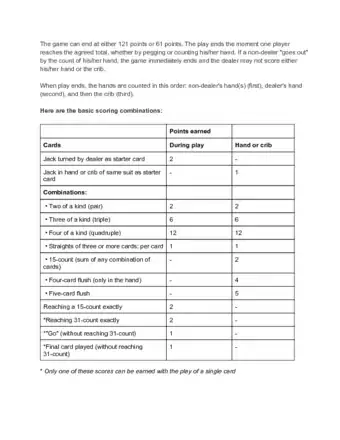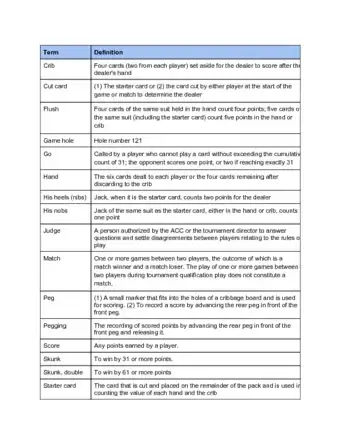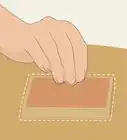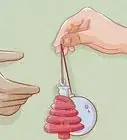wikiHow is a “wiki,” similar to Wikipedia, which means that many of our articles are co-written by multiple authors. To create this article, 55 people, some anonymous, worked to edit and improve it over time.
wikiHow marks an article as reader-approved once it receives enough positive feedback. This article received 11 testimonials and 92% of readers who voted found it helpful, earning it our reader-approved status.
This article has been viewed 1,233,579 times.
Learn more...
Cribbage is a challenging game that can be played with 2-6 people (not 5). Although it may seem intimidating at first, the basic game is very easy to learn and play. If you have a cribbage board (or pen and paper) and a deck of cards, you're ready!
Steps
Setting Up and Forming Hands
-
1Get a cribbage board (including pegs) and a standard deck of 52 cards. For this game, the jokers are not used. Each player will need two pegs for scoring -- these can be found underneath the board. The set may include additional pegs for keeping track of match scores. If a proper board is unavailable, the players can keep score with pencil and paper.
- The two pegs for each player are used to indicate the score in the previous turn and the score of the current turn. This way, any math can be easily checked and double-checked.
- The first to accumulate 121 points wins. This often occurs in the middle of a deal; the game then ends immediately. Two trips around the board (with your pegs) is equivalent to this. If you are playing a short game, one trip signifies the end, with a player winning at 61.
-
2Pick a dealer and deal the hand. To determine who deals first, any player picks up the deck and shuffles it 2 or 3 times. The deck is placed face down on the table; each player pulls out one card. The person with the lowest card is the dealer. The dealer deals 6 cards to each player.
- Being the dealer has its upsides and downsides. The dealer gets the advantage of the crib; however, the non-dealer(s) immediately gets 3 points (for compensation[1] ) and can "peg out" before the dealer even gets a chance to tally his/her score and win (because the dealer goes last).
- If you're playing multiple rounds, rotate dealers just like you rotate turns.
Advertisement -
3Form the "crib." Each player looks at their 6 cards and decides which 4 to keep in his hand and which 2 to discard face-down into a pile near the dealer called "the crib." This is a hand that is looked at at the end of the game and is reserved for the dealer and the dealer only.
- The crib is an enormous part of cribbage strategy. If you are the dealer, you can save away your good cards in this crib for later. If you are not the dealer, you must try to give the dealer as weak of a hand as possible, while not jeopardizing your own play.
-
4Flip the up-card or starter card. The player who did not deal cuts the deck to determine the top card. Then, the dealer should flip it over. Both players will use this card, called the "cut," as a wild fifth card to count points at the end of the round.
- If this "up-card" is a Jack, the dealer gets to peg 2 points immediately. This score is called "his heels" or "his nibs."[2]
Scoring Points
-
1Start counting. Players alternate laying cards down in their own piles, starting with the non-dealer. As they play each card, they call out the value of the total. Face cards have a value of 10; all others are worth their numeric value. Aces are always only worth 1 point. Suits do not matter in this round; only numeric values. Play stops at 31 (or when no one can lay down a card).
- If the first player lays a 3 and the second player lays a 4, the first player calls out, "3" and the second player calls out "7." Though they're in separate piles, it's the cumulative total of all the cards.
- The cards are kept in these separate piles because at the end of the game, each person's hand is tallied on its own. However, all players should be able to see every card played.
-
2Start "pegging." Make pairs, runs, and other combinations to score points. While you're laying cards and thinking about not going over 31, use what your opponent(s) is laying to your advantage. You get extra points for pairs, runs, and certain numbers. As you score, move your peg around the board.
- If either player reaches 15 points exactly, this earns him 2 points.
- Points are also earned and pegged for pairs (and triplets, etc.). For example, player 1 lays down a 7 and Player 2 immediately follows with another 7, which would earn him 2 points. If Player 1 then lays down a third 7, he earns 6 points. The fourth seven would be worth 12 points. (Note: if Player 2 is not able to lay down any other card without exceeding 31, and Player 1 has the fourth seven, he can lay it down and earn the 12 points.)
- Sequences also score points. They must be consecutive cards, but not necessarily in order. For example: The first player plays a 4, second player plays a 6. If the first player now plays a 5 he would score three points for completing a run of 3. If the second player now plays a 3 or a 7 he would then score 4 points for making a run of 4.
- After "31" (or as close as possible in the hand), the person laying down the last card takes a point for having the final card. If the last card makes exactly 31, the player gets 1 additional point.
-
3Continue until a player cannot lay down another card without exceeding 31. At this point, he says "Go." If the other player can still lay down another card without exceeding 31, he must do so for as many times as necessary. Once he lays down as many cards as he can without going over 31, he says "Go" and earns 1 point. However, if the total he ends up with is exactly 31, he earns 2 points.
- It is 1 point per "Go," not 1 point per card able to be laid down without exceeding 31. If you can lay 1 card without exceeding 31, you get 1 point; if you can lay 3 cards without exceeding 31, you still get 1 point.
- This player can also get extra points for runs and the like during this time.
- It is 1 point per "Go," not 1 point per card able to be laid down without exceeding 31. If you can lay 1 card without exceeding 31, you get 1 point; if you can lay 3 cards without exceeding 31, you still get 1 point.
Finishing the Round
-
1Count up the cards to get your final score. Once all cards have been played, it is time to count them up. The person to count first is the non-dealer(s), then the dealer, then the crib. Your hand consists of the four cards you played, plus the cut card. This is why you kept them in separate piles! If you are the dealer, count your original hand and the crib separately.
- You score one point if you hold the Jack of the suit that was cut.
- Pairs, triples and quadruples count -- 2, 6 and 12 points, respectively.
- Sequences (e.g. 6-7-8) do not have to be the same suit, and count as 1 point per card. They must consist of at least three cards.
- Any combination of cards that add up to 15 counts as 2 points (even if it took all five cards to do it). You may use a card more than once in different combinations.
- A flush (all four cards are the same suit) is worth 4 points.
- The cut cannot give you a flush. It gives a fifth point if it extends a 4 card flush to a 5 card flush, but 3 spades and a heart don't score flush points if you cut a spade. (When counting the crib, only 5 card flushes score.)
- If all four cards in the crib are the same suit, no points can be taken unless the fifth card is also that same suit. Then 5 points are pegged.
-
2Consider the "Muggins" variation. Because patterns and scoring are so intricate in this game, lots of players like to take advantage of the possibility of their opponent flubbing up and missing would-be points in their hand. This is called the "Muggins" rule.
- Each player tallies up their hand aloud. If they finish and another player notices points they missed, they call out, "Muggins!" and receive those up-for-grab points. If playing this variation, it's important to be thorough!
-
3Play until one person reaches 121. If no player has made two trips around the board (or one trip for a short game), play another round. The next person then deals and the game continues as normal. When someone does reach 121, the game immediately stops. That person is the winner, even if other players have yet to take their turn.
Playing with Strategy
-
1Don't start off with a 5. Odds are the next player has a card in their hand worth 10. If you start off with a 5, they'll probably be able to land on 15, scoring them 2 points. Ideally start off with a 4 -- it has the least amount of value to you.
- Aces or deuces should be kept to make a 31 or to upset your opponent's "Go."[3] Generally lower cards are useless, but not in this case.
-
2Think about what you put into the crib. If you are not the dealer, it's best to avoid putting 5s into the crib (if there are any tens in there at all, that's an automatic 15). Obviously, avoid putting in pairs and numbers that are consecutive (6 and 7, for example, to avoid sequences). Ace and King are pretty safe to put in, as they are too low and too high to be any real threat.
- If you are the dealer, it's a magic touch between "salting" your crib with good cards but still keeping a decent hand for play.[3] Try to envision what you think the other players will toss away and working off of that.
-
3Avoid landing on 21. Cribbage is very much a game of thinking ahead. You are setting your opponent up for each play they make, allowing or not allowing them points. In as much as you want to avoid 15, also avoid 21. A ten or a face card and voila! 31 they've got.
-
4If you're close to winning, don't worry about the crib. You've played four rounds already and you're at 116 points? Great -- toss whatever you'd like into the crib, just keep the best hand possible. Odds are you won't make it to the end of the game, so don't worry about crib strategy. Just play your best cards and get out of there! The game ends as soon as you win, no crib counting allowed.
Cribbage Help
Community Q&A
-
QuestionDo I shuffle the cards at the end of each turn playing cribbage?
 Brett MeyerCommunity AnswerYes. The cards are shuffled by the dealer, and then the dealer offers the deck to his opponent (or the player to his left if there are more than 2 players) for the cards to be cut by that player. The dealer is allowed to re-shuffle the cards after they have been cut, but if he does so, the cards must be cut again (see above) prior to him dealing them out. Only one re-shuffle is allowed by the dealer per turn.
Brett MeyerCommunity AnswerYes. The cards are shuffled by the dealer, and then the dealer offers the deck to his opponent (or the player to his left if there are more than 2 players) for the cards to be cut by that player. The dealer is allowed to re-shuffle the cards after they have been cut, but if he does so, the cards must be cut again (see above) prior to him dealing them out. Only one re-shuffle is allowed by the dealer per turn. -
QuestionDoes a player have to play his highest card or can he play a lower card to try for more points?
 Community AnswerYou can use any of your cards at any time that you haven't used as long as you don't go over 31.
Community AnswerYou can use any of your cards at any time that you haven't used as long as you don't go over 31. -
QuestionHow many points would I get for three tens played?
 Community AnswerThe first 10 played earns 0 points, the second 10 played earns 2 points as a pair, and the third 10 played earns 6 points.
Community AnswerThe first 10 played earns 0 points, the second 10 played earns 2 points as a pair, and the third 10 played earns 6 points.
Things You'll Need
- A cribbage board (or pen and paper)
- Two pegs for each player
- A standard deck of cards
- At least 2 players
References
About This Article
To play Cribbage, you'll need a Cribbage board, pegs, and a deck of cards. The goal of Cribbage is to score 121 points before your opponent by creating different card combinations. To start the game, shuffle the deck and have each player take half of it. Whoever has the lowest card on the bottom of their half deals first. Deal 6 cards to each player. Then, each player looks at their hand and chooses 2 cards to remove from the game. Place these cards off to the side face-down. These cards are called the "crib." Next, cut the deck and reveal the top card on the bottom half. This card is the starter card. The starter card is used to help calculate points at the end of play. If the starter card is a Jack, the dealer starts the game with 2 points automatically. After the starter card is revealed, the non-dealing player reveals a card from their hand. Then, the dealer reveals a card on their side of the table. Each card’s numeric value is added to the previous card’s numeric value to track the score up to a total of 31, with kings, queens, and jacks counting for 10, and aces counting as 1. Each player announces the running total as they play their card. For example, the non-dealing player may put a 6 down and say, “6.” The dealer then may play an 8 and say, “14.” The running total can never exceed 31. If a player cannot play a card from their hand without exceeding 31, they say, “Go,” and the other player scores 1 point. The scoring player may then play another card without exceeding 31. If a player reaches exactly 31, they get 2 points. After reaching 31 or “Go,” the running total resets to 0 and the player that failed to score plays their next card. Keep track of the score by moving your peg into the corresponding slot on the board. Move it every time you score and add your points together. You can also score points by creating combinations of cards while playing your hand out, which is called “pegging.” These points are calculated at the end of the round after all of the cards have been played. When both players have played all of the cards in their hands, the cards are counted for points in the following order: non-dealer’s hand, dealer’s hand, then the crib. The starter card is assumed to be a part of both player’s hands while they’re scoring points. If you have any 2 cards that add up to 15, you score 2 points. If you played 2 cards of the same rank, you get 2 points. You get 6 points for playing 3 of the same card in a row, and 12 points for playing 4 of the same cards in a row. You also score 1 point for every card played in an ascending or descending order. For example, if the dealing player plays a 3, followed by another 3 and a 4, they’ve earned 3 points. The dealer counts their hand first, followed by the non-dealing player. Then, the crib is counted by the dealing player. Any combinations in the crib are scored for the dealer. Scoring for the crib is counted the same way as regular play, with one adjustment. If the face-up card on top of the deck shares a suit with a jack in the crib, the dealing player is awarded an additional point. When you're finished scoring a round, the non-dealing player from the previous round shuffles the cards and deals out a new hand. Keep playing until one player reaches 121 points and wins! For more tips, including how to score each hand and end the round, read on!





-Step-7-Version-3.webp)




-Step-7.webp)







-Step-7-Version-3.webp)



































